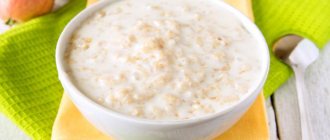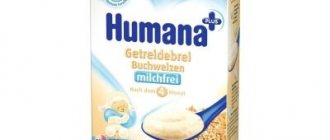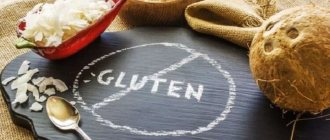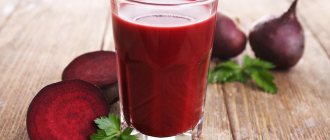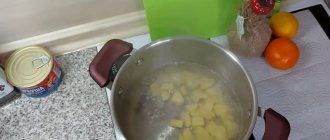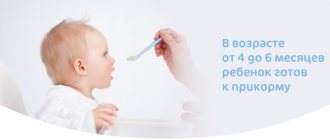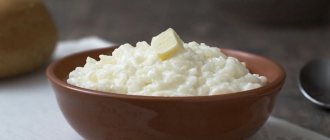Cooking with water
Rice porridge with water for a child is where a child’s acquaintance with this cereal begins. For the first time, we introduce rice into complementary foods in a crushed state, without adding fruit or milk.
Let's look at what you need to prepare:
- rice – 1.5 tbsp. spoons;
- water for baby food – 320 ml;
- salt.
- Pour water into a saucepan and wait for it to boil.
- Add a little salt and add the pre-washed cereal.
- The porridge is cooked for about half an hour. Then the dish is left warm for about fifteen minutes to finish cooking.
If the toddler is very small, then the finished dish will be ground for him using a blender to a puree.
When it's time to taste the rice
It depends on what product you decide to start feeding your baby with. It is better to introduce vegetable purees first and only then switch to porridge. If you start expanding your baby’s diet with rice, then it should be introduced from 6 months for breastfed babies and from 4 months for formula-fed babies.
It should be noted that many advise introducing rice porridge first into complementary foods, due to its ability to envelop the baby’s stomach lining and is quickly absorbed by the body, as well as the minimal risk of developing allergies. But if you notice that your child is prone to constipation, you should hold off on rice, and it’s better to start complementary feeding with buckwheat.
I started complementary feeding for my son with vegetable puree. Then, at 7 months, we introduced buckwheat porridge, and only 3 weeks later we introduced rice. But buckwheat still remains a priority for us; the baby likes it much more.
It is worth noting that rice should not be overused due to its ability to hold the intestines together. Therefore, try to give it to your baby no more than two or three times a week, and to those prone to constipation - once or twice every two weeks.
Milk porridge
Rice porridge with milk for a child is a more nutritious dish than one prepared using only water. However, here you need to be careful and be absolutely sure that the little one is not allergic to milk protein.
To prepare, take the following products:
- cereal – two hundred grams;
- half a liter of milk;
- two hundred ml of water;
- Art. spoon of sugar;
- 30 grams of butter (butter).
- Rinse the rice several times. Pour the cereal into a saucepan and add water.
- After boiling, continue cooking until there is very little water left. Don't forget to stir constantly.
- Add milk and sugar. Continue cooking over low heat until fully cooked.
You need to cook for about 15 minutes. It all depends on what kind of porridge you want: thick or liquid. The main thing is that the rice has time to cook.
My son loved this porridge when he was very little, but now he prefers the dairy-free version.
Benefits of milk rice porridge
- does not irritate the walls of the stomach or intestines;
- porridge contains gluten, it is this that promotes the active activity of food enzymes present in the gastrointestinal tract;
- the grain has a mucous-starch component, it helps coat the stomach, which protects it from side effects and irritants;
- qualitatively and quickly replenishes energy reserves that children so need;
- source of carbohydrates, folic acid and carotene, magnesium, potassium and calcium, thiamine.
Sometimes it is very difficult to choose the right food for a child. As for rice porridge cooked with milk, it can solve a similar problem without additional difficulties or hassle. In addition, it has one main advantage - quick and easy preparation.
Dish with pumpkin and milk
Pumpkin has a beneficial effect on digestive processes, so its appearance in a child’s diet, and even together with rice and milk, should have a positive effect on the baby’s well-being.
If the child is one year old, and he was previously familiar with both rice, pumpkin, and milk, adaptation was successful, and there are no allergies, then you can prepare porridge according to this recipe.
You will need:
- milk - two glasses;
- pumpkin pulp - four hundred grams;
- half a glass of rice (round);
- teaspoon sugar;
- thirty grams of butter.
- After washing, the rice is boiled in water for ten minutes, until half cooked.
- Pumpkin is cooked in milk in a separate container.
- After the vegetable has become soft enough, you can add the prepared rice and sugar.
- Cook over low heat. Once cooked, add oil.
The benefits and harms of rice for babies
Many pediatricians and pediatric gastroenterologists advise starting complementary feeding with this porridge. Once in the stomach, it gently envelops its mucous membrane and for absorption does not require the active work of the enzyme system, which has not yet been formed. This product has a huge supply of vitamins and useful elements:
- vitamins B and E, which rice is rich in, have a positive effect on the condition of the skin and nails, as well as on the functioning of the nervous system. Their daily intake into the body is very important during periods of intensive growth;
- amino acids included in the cereal play a role in the formation of new cells;
- iron, selenium, zinc and iodine help strengthen the immune system and mental development;
- complex carbohydrates help the body, which expends enormous reserves of energy, to recover and build muscle mass;
- lecithin activates brain activity.
The beneficial properties of rice include the fact that it removes toxins and other harmful substances from the body, normalizing the functioning of the gastrointestinal tract and kidneys.
Rice porridge is suitable for feeding children in the first year of life due to the absence of gluten, a cereal protein that can cause a severe allergic reaction.
Despite its great benefits, rice has some features that parents should consider:
- rice strengthens the intestines, so if a child has difficulty defecating, pediatricians recommend giving up rice for a while until peristalsis improves;
- The cereal contains phytic acid, which negatively affects the absorption of calcium and iron by the child’s body;
- if a child has stomach colic, rice should be excluded from the menu.
Rice is considered a hypoallergenic food, but in some cases it can cause constipation, indigestion, nausea and bloating. This reaction occurs in children with fiber intolerance. This diagnosis can be made by a doctor after conducting the necessary examination and tests. If it is confirmed, eating rice and other foods that contain fiber is prohibited.
How to introduce porridge into a baby’s diet - video
Porridge with apples
For this recipe you need to have:
- five tbsp. spoons of rice;
- half a liter of milk;
- apple;
- on the edge of a teaspoon of salt;
- twenty grams of oil;
- Art. spoon of sugar.
- The washed rice is poured into a pan with milk and salt is added.
- Cook over medium heat, and after boiling, turn to low heat. Cook for about ten minutes.
- The apple is peeled and cut into pieces.
- When the rice becomes soft, you need to pour the prepared apple and sugar into the pan. Cook until the fruit is soft.
- Once cooked, add oil.
With berries
This dish will be very useful for a growing organism.
To prepare, take the following ingredients;
- two tbsp. spoons of berries (any, most importantly fresh);
- a glass of squeezed berry juice;
- Art. spoon of cereal;
- half a teaspoon of butter;
- Art. spoon of sugar.
- The berries are washed, filtered through a sieve, squeezing out the juice. Boil in water.
- Pour juice into the pan, add cereal and sugar.
- When the cereal has become soft, remove from heat and add oil.
Rice jelly
You will need:
- fifty grams of sugar;
- three grams of salt;
- two tbsp. spoons of rice.
- The rice is poured with a liter of water, always cold, and left for twelve hours.
- Add half a liter of water and put it on the stove.
- The cooking process takes an average of two hours with constant stirring.
- The finished rice is ground in a blender, sugar and salt are added. After this, boil twice more.
We use a slow cooker
In addition to the usual method of preparing porridge on the stove, you can use the recipe in a slow cooker.
Dish ingredients:
- milk – eight hundred ml;
- two tbsp. spoons of sugar;
- salt;
- a glass of rice cereal;
- butter - thirty grams.
- Rice is washed thoroughly and poured into a bowl.
- Pour in milk, add sugar, as well as salt and butter. Everyone is stirred.
- Set the “Porridge” mode. It takes twenty-five minutes to prepare. After which you can still switch to “heating” for about ten minutes.
Now you know the recipe for rice porridge. Remember, if your baby is allergic to milk, you can prepare a dairy-free version. For a toddler over a year old, do not forget to experiment, adding new ingredients each time, thereby making his menu more varied.
When and how to introduce complementary foods
The first complementary foods should be introduced into the child’s diet no earlier than 6-7 months. Until this time, the baby needs breast milk to satisfy its energy and nutritional needs. The first rice porridge should be cooked only in water and without adding sugar. Start giving porridge with 0.5 teaspoon in the morning. If the child does not show any allergic reactions within 24 hours, the portion can be doubled next time. According to this scheme, it is necessary to gradually increase the amount of rice porridge cooked in water eaten. Under no circumstances should you stop breastfeeding your baby. When you bring the amount of porridge consumed by your baby to the norm for his age, you should replace it with only a few feedings per week.
It is best to start giving your baby rice porridge for breakfast, so you can track his reaction to the product throughout the day. If your baby refuses to eat an unfamiliar type of food, add a little expressed breast milk to the rice porridge. It will be easier for the child to perceive the new product.
